#luftwaffe attacks
Text
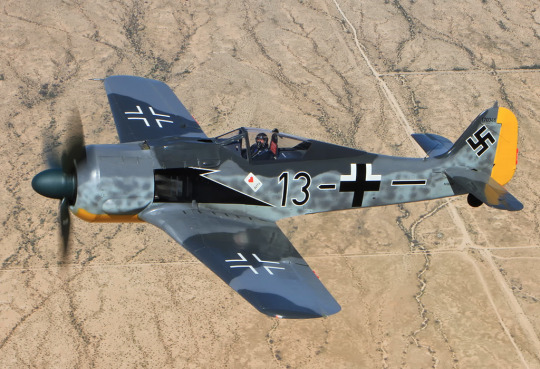
1943 Arado Flugzeugwerke FW-190 A-5 long range night fighter bomber aircraft over Casa Grande, Az
#Flugzeugwerke#FW-190#A-5#JaBo Rei#Night fighter#Fighter Bomber#attack aircraft#Luftwaffe#Vintage aircraft#Würger#warbird#airplane#aircraft#plane
128 notes
·
View notes
Text

Henschel Hs 123 ground attack/dive bomber, location and date unknown
#germany#ww2#luftwaffe#ww2 aircraft#henschel#hs 123#ww2 dive bombers#ground attack#ww2 german ground attack aircraft
42 notes
·
View notes
Photo
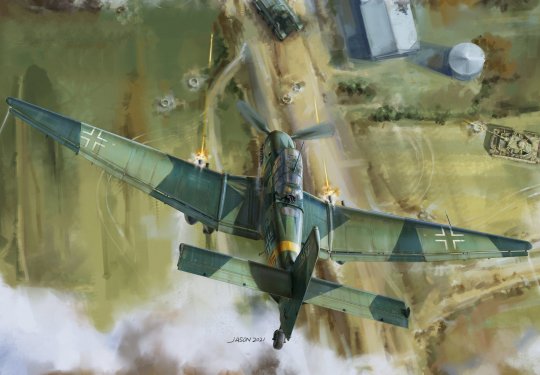
Junkers Ju 87G Gustav
©Artwork by Jason
#WWII#Artwork#Jason#Luftwaffe#Aviation militaire#Military aviation#Bombardier en piqué#Dive bomber#Avion d'attaque au sol#Ground-attack aircraft#Junkers Ju 87#Ju 87#Stuka
28 notes
·
View notes
Text
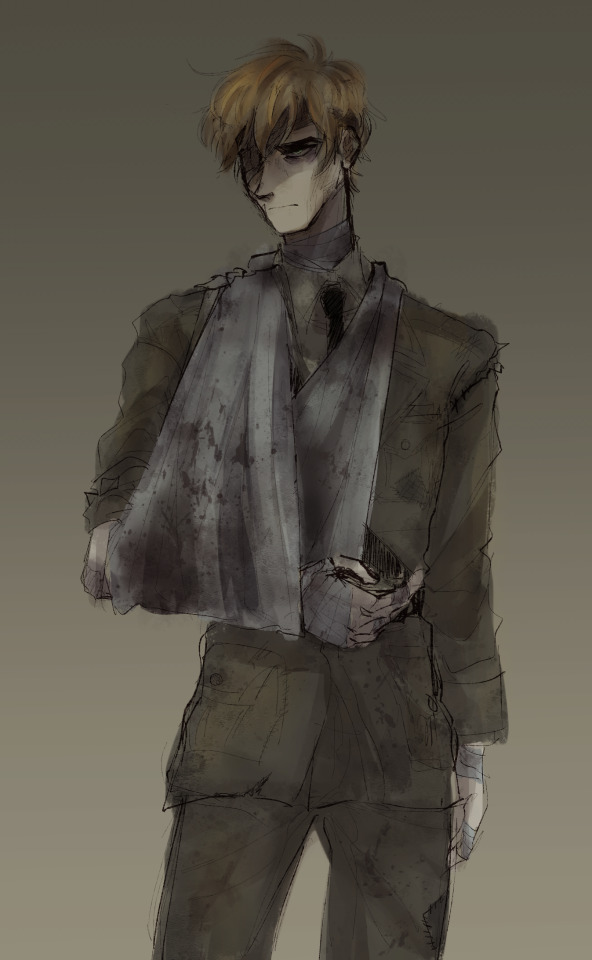
From 7 September 1940, London was systematically bombed by the Luftwaffe for 56 of the following 57 days and nights. Notable attacks included a large daylight attack against London on 15 September, a large raid on 29 December 1940 against London resulting in a firestorm known as the Second Great Fire of London and a large raid on the night of 10–11 May 1941.
[Wikipedia]
everyday i think about him and just can't stop
410 notes
·
View notes
Text
A nightingale sang in the London Blitz
When exactly was that certain night, the night Aziraphale and Crowley met — and spoke for the first time in 79 years in the midst of the London Blitz?
And what’s the deal with the nightingale’s song, really?
Grab something to drink and we’ll look for some Clues below.
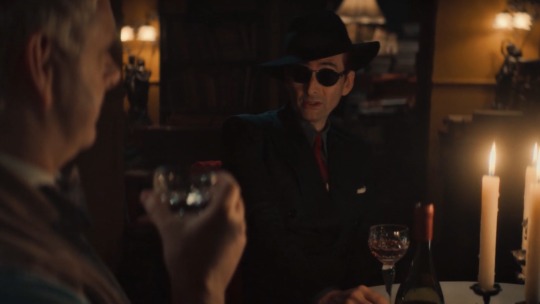
The night they met
The Blitz, short for Blitzkrieg (literally: flash war) was a German aerial bombing campaign on British cities in the WW2, spanning between 7 September 1940 and 10 May 1941. The Luftwaffe attacks were carried out almost non stop, with great intensity meant to force a capitulation and similarly strong impact on British life and culture at the time.
Starting on 7 September 1940, London as the capital city was bombed for nearly 60 consecutive nights. More than one million London houses were destroyed or damaged, and more than 20,000 civilians were killed, half of the total victims of this campaign.
The night of 29 December 1940 saw the most ferocity, becoming what is now known as the Second Great Fire of London. The opening shot of the S2 1941 minisode is a direct reference to recordings of that event, with the miraculously saved St Paul’s Cathedral in the upper left corner.
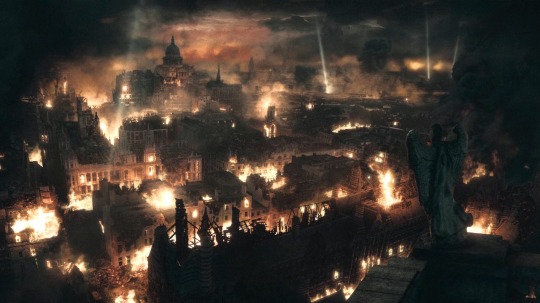
The actual raid lasted between 06:15 and 09:45 PM, but its aftermath continued for days. The old and dense architecture of this particular part of the city turned into a flaming inferno larger than the Great Fire of 1666. Multiple buildings, including churches, were destroyed in just one night by over 100,000 bombs.
Incendiary bombs fell also on St Dunstan-in-the-East church that night, the real-life location of this scene as intended by Neil. It was gutted and again claimed by fire in one of the last air rides on 10 May, when the bomb destroyed the nave and roof and blew out the stained glass windows. The ruins survived to this day as a memorial park to the Blitz.
Such a delightfully Crowley thing to do: saving a bag of books with a demonic miracle adding to the biggest catastrophe for the publishing and book trade in years. 5 million volumes were lost, multiple bookshops and publishing houses destroyed in the December 29th raid alone.
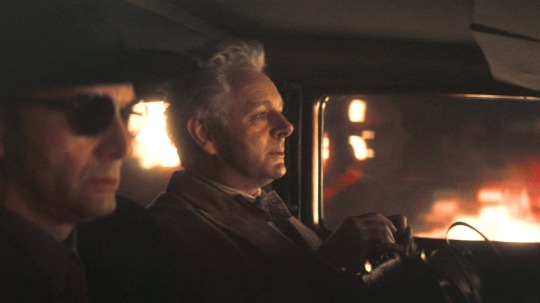
Even without this context, judging by the seemingly unending night, overwhelming cold and darkness, broken heating at the theatre, and seasonal clothing (like Aziraphale and Crowley’s extremely nice winter coats), it’s rather clear that it was the very beginning of the year 1941.
Everything suggests that Aziraphale and Crowley’s Blitz reunion happened exactly 1900 years after their meeting in Rome — which, according to the script book, took place between 1 and 24 January 41 (Crowley was right: emperor Caligula was a mad tyrant and didn't need any additional tempting; there's a reason why he was murdered by his closest advisors, including members of his Praetorian Guard, on 24 January 41).
Interestingly, both events involved a role reversal in their otherwise stable dynamic, with Aziraphale spontaneously taking the lead instead of letting the demon be the one to do all the tempting and saving, and ended with a toast.
The S2 Easter Egg with the nuns of the Chattering Order of St Beryl playing table tennis at the theatre suggests that the Blitz meeting happened on a Tuesday afternoon, which doesn’t match any of the above mentioned days, but sets the in-universe date for 7 January 1941 or later.
The Chattering Order of Saint Beryl is under a vow to emulate Saint Beryl at all times, except on Tuesday afternoons, for half an hour, when the nuns are permitted to shut up, and, if they wish, to play table tennis.

The nightingale
January means one thing: absolutely no migratory birds in Europe yet. They’re blissfully wintering in the warm sun of Northern Africa at the time. But, ironically, when the real nightingales flew off, a certain song about them suddenly gained popularity in the West End of London.
It might be a shock, but A Nightingale Sang in Berkeley Square wasn’t a hit from the start — even though its creators, Eric Maschwitz and Manning Sherwin, were certainly established in their work at this point. The song was written in the then-small French fishing village of Le Lavandou shortly before the outbreak of the Second World War with first performance in the summer of 1939 in a local bar, where the melody was played on piano by the composer Manning Sherwin with the help of the resident saxophonist. Maschwitz sang his lyrics while holding a glass of wine, but nobody seemed impressed. It took time and a small miracle to change that.
Next year, the 23-year-old actress Judy Campbell had planned to perform a monologue of Dorothy Parker’s in the upcoming Eric Maschwitz revue „New Faces”. But somehow the script had been mislaid and, much to her horror, replaced with the song A Nightingale Sang in Berkeley Square. She had never professed to be a singer but even so, she gathered her courage and went out onto the moonlit set dressed in a white ball gown. Her heartfelt rendition of the now evocative ballad captured the audience’s imagination and catapulted her West End career to stardom.
It was precisely 11 April 1940 at the Comedy Theatre in Panton Street and the revue itself proved to be a great success — not only it kept playing two performances nightly through the Blitz, but also returned the next year. And the still operating Comedy Theatre is mere five minutes on foot from the Windmill Theatre, where Aziraphale performed in 1941, and not much longer from his bookshop.
Now, most Good Omens meta analyses focus on Vera Lynn’s version of the song from 5 June 1940, but it didn’t get much attention until autumn, specifically 15 November, when Glenn Miller and his orchestra published another recording. And Glenn Miller himself is a huge point of reference in Good Omens 2.

According to the official commentary the infamous credits scene is establishing Aziraphale and Crowley’s final resolve for the next season using the same narrative device The Glenn Miller Story (1954) does in its most crucial scene. It starts with the tune (and audio in general) totally flat, then adds a piano on one side, and gradually becomes fully multidimensional. The Good Omens credits not only emulate the same sound effect, but bring it to the visual side of the narrative by literally combining the individual perspectives of the two characters together. Even though they’re physically apart, their resolve — and love to each other — brings them even closer than before. Aziraphale smiles not because he’s being brainwashed, but because he knows exactly what to do next.
Some of you might have noticed that Tori Amos’s performance for Good Omens is actually a slightly shortened version of Miller’s recording — much less sorrowful than Vera Lynn’s full lyrics that include i.a. this bridge:
The dawn came stealing up
All gold and blue
To interrupt our rendez-vous
I still remember how you smiled and said
Was that a dream or was it true?
Which is a huge hint when it comes to what we can expect from the main romantic plot line in the Good Omens series. The original song introduces an element of the doubt — it seems like there was no nightingale at all, only the mirage woven by the singer clearly intoxicated with love, much like Aziraphale and Crowley for the length of the last six episodes. Crowley’s comment in the season finale might allude to that interpretation, stating that there are no nightingales — never have been. It was all a dream. But the version we’re working with here is short and sweet, and devoid of that doubt. In the Good Omens universe angels were actually dining at the Ritz, the streets were truly paved with stars (or will be shown as such in the next season), and a nightingale really sang in Berkeley Square, as the omniscient, omnipresent, and omnipotent narrator, God Herself, had shown us.
All in all, it’s not an accident that the “modern” swing ballad activating Aziraphale’s memory and opening the 1941 minisode is the Moonlight Serenade by Glenn Miller. It’s a track naturally associated with A Nightingale Sang in Berkeley Square when it comes to music style and the sentiment in the lyrics.
But why the sudden popularity? In the great uncertainty and hardship of the Blitz, A Nightingale Sang in Berkeley Square provided solace and escapism for listeners, offering a glimpse of hope and love amidst the darkness of war. It became a universal anthem of resilience and a reminder of the power of love transcending difficulties. By January 1941 the whole city knew this tune by heart, including a certain West End aficionado with a cabinet full of theatre programs in his bookshop. Thanks to Maggie’s grandmother, he most probably had a record at hand to play during his spontaneous wine night with Crowley. We can only suspect the details, but it was was mutually established as their song exactly at that time or soon afterwards. Pretty sure we will see a third installment of that minisode for many, many reasons, but especially because of this “several days in 1941” answer by Neil:
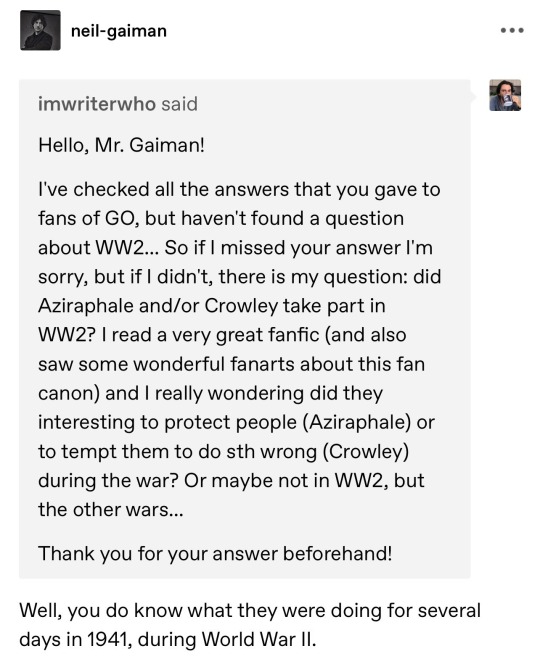
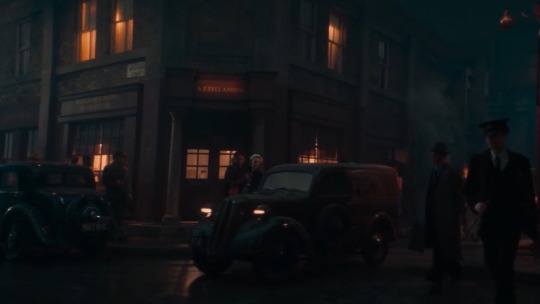
The Man Hunt
In 1941 A Nightingale Sang in Berkeley Square gained even more popularity as the romantic theme of the Fritz Lang’s newest film Man Hunt. The 1939 story by Geoffrey Household first appeared under the title “Rogue Male” as a serial in the Atlantic Monthly Magazine where it received widespread comment, soon becoming a world-wide phenomenon in novel form. Its premise criticizes Britain's pre-war policy of appeasement with Germany, ready to sacrifice its own innocent citizens to the tentative status quo. Sounds a bit like Heaven's politics, right?
Yes, I'm trying to make you watch old movies again — like all the other classics, Man Hunt (1941) is easily available on YouTube and other streaming websites.
The next part will include spoilers, so scroll down to the next picture if you prefer to avoid them.
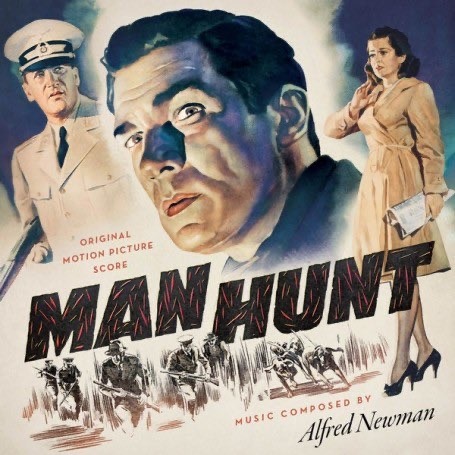
The plot of the movie seems simple enough: the tall, dark, and handsome Alan Thorndike, who nearly assassinates Hitler, narrowly escapes Germany and back in London continues to evade the Nazi agents sent after him with the help of a young trench-clad “seamstress” named Jerry, bridging the class divide and becoming unlikely friends-partners-romantic interests. It doesn’t end well though.
Jerry's small London apartment serves as a hideout for Alan when he was being followed by Nazis, similarly to how Aziraphale's bookshop is a safe haven for both Crowley and Gabriel in S2. She helps the man navigate the streets and eventually out of London — by sacrificing herself and getting forcefully separated from him by a patrolling policeman. The last time they see each other, Alan watches Jerry look back at him yearningly and disappear in the fog, followed by the elderly officer.
Unfortunately in the next scene we learn that the latter is a Nazi collaborator and helps the agents apprehend Jerry in her own flat. Staying loyal to her love and uncooperative, she’s ultimately thrown out of a window to her death, but posthumously saves Alan once again — through the arrow-shaped hatpin he gifted her earlier that is presented to him as the evidence of her off-screen fate.
Long story short, thanks to Jerry’s sacrifice Alan not only survives, but is able to join the war that broke out in the meantime and go back to Germany, armed with a rifle and a final resolve to end what he started, no matter how long will it take. The justice will be served and the dictator will pay with his life for his sins.
I wouldn’t be myself without mentioning that the main villain has a Roman chariot statue similar to the one in Aziraphale’s bookshop, an antique sculpture of St Sebastian (well-known as the gayest Catholic Saint) foreshadowing his demise, and a chess set symbolizing the titular manhunt/game of tag with the protagonist.
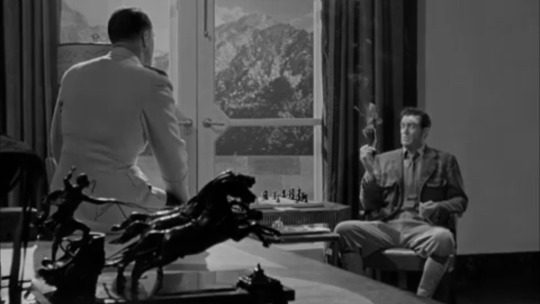
Aziraphale’s song
Will Aziraphale sacrifice himself as well? Or has he already? If his coin magic trick can be any indicator, we should expect at least a shadow of a danger touching the angel’s wings soon.
Let’s sum up the 1941 events from Aziraphale’s perspective: the very first time they’ve interacted after almost a century, Crowley actively sabotaged his entire existence twice by stepping onto a holy ground and by being outed by agents of Hell, both on the very same night and both because of his undying dedication to the angel. That’s enough of a reason not only for performing an apology dance, but also maintaining a careful distance for Crowley’s sake for the next 26 years. Only when he heard that his idiot was planning to rob a church, he gave up since he “can't have him risking his life”.
That’s when Crowley, sitting in a car parked right under his bookshop, offered him a ride. It wasn’t even subtle anymore. It was supposed to be a date, this time both of them understood it. But Aziraphale wouldn’t risk Crowley’s safety for his own happiness, especially not when he can name his feelings towards him and knows that they are reciprocated — the biggest lesson he learnt back in 1941.
So he did what he’s best at, he cut Crowley off again, but this time with a promise of catching up to his speed at some point. Buddy Holly’s Everyday, which was originally planned to play afterwards instead of the Good Omens theme, adds additional context here:
No, thank you. Oh, don’t look so disappointed. Perhaps one day we could... I don't know… Go for a picnic. Dine at the Ritz.
Aziraphale, carefully looking around and feeling observed through the whole conversation in the Bentley, consciously used the “Dine at the Ritz” line from A Nightingale Sang in Berkeley Square, from their song, as a code only the two of them understand. Not as a suggestion to go out for a meal, but a promise. A hope for the privilege of being openly in love and together — maybe someday, not now, when it’s too dangerous — even if it leads to a bad ending.
Fast forward to 2023 when for one dreadful moment Crowley’s “No nightingales” robbed Aziraphale even of that semblance of hope. He looked away, unable to stop his tears anymore. Only their kiss helped him pull himself together and make sure that a nightingale did sing the last time he turned — just like in their song — this time without a smile, as a goodbye.
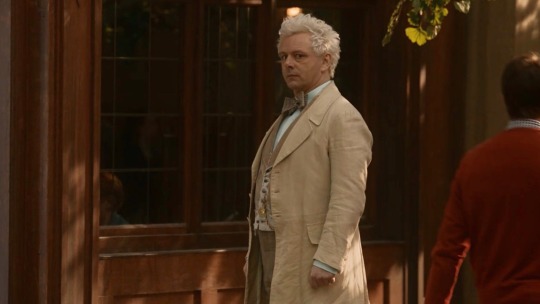
#a nightingale sang in the london blitz#the song is a code#and is miracled as a sign#aziraphale needs a hug#no nightingales#history rant#yuri is doing her thing#the good omens crew is unhinged#neil gaiman#st dunstan-in-the-east#1941 minisode#1941 flashback#a nightingale sang in berkeley square#good omens#good omens meta#good omens 2#go2 meta#go2#ineffable husbands#aziraphale#crowley#1941 aziraphale#1941 crowley#the blitz#man hunt (1941)#the glenn miller’s story (1954)#why am i like this#why do i do this to myself#long post
313 notes
·
View notes
Text
Since the announcement that two or three new versions of Ghosts are in the works, I've been thinking about what sort of ghosts we might get to see / I'd like to see in a German adaptation and put together a list of my ideas. You will see some similarities with our beloved original ghosts as well as completely new characters, and I did my best to find a balance between male and female characters and include a variety of historical eras.
This is obviously just a very basic list with some notes but I do have thoughts about these characters (how they died, what powers they might have, their inner conflict etc.) so if you'd like to know more, please ask (also German producers, I hereby officially volunteer as tribute writer)!
German Ghosts
Female Neanderthal (40,000 BC)
Neanderthals were named after the German Neander valley so I think it's only fair to include a Neanderthal in the show. Since no one needs a Robin 2.0, I'd make the character female and give her a dog because ghost animals are fun and we need more of them.
Roman & German (9 AD)
Two guys - let's call them Marcus and Alber - who fought on opposite sides died in the Battle of the Teutoburg Forest, became ghosts and eventually best friends. They'd rather die again than admit that to anyone, though.
Bog Girl (600 AD)
A little girl who haunts the marshlands around the house but not the property itself. Most of the ghosts avoid her until the Naturalist gets curious and starts to befriend her.
Plague Ghosts (Mid-1600s)
A group of victims of the 30 Years' War whose deaths were caused by famine and disease and not the war directly (though they insist they died 'in the war').
Naturalist (Late 1700s)
A scientist like Alexander von Humboldt and Charles Darwin who embraces becoming a ghost from the get go and does various experiments (on himself and the others) to figure out how ghost rules work and what is and isn't possible.
Composer (Early 1800s)
A young composer who has a (perceived) rivalry with Beethoven because he's lost part of his hearing. Think German equivalent of Thomas Thorne.
Female Soldier (Early 1800s)
Based on stories like that of Friederike Krüger, this woman posed as a man and joined the army during the Napoleonic Wars.
Woman in White (Late 1800s)
The lady of the house at the time. After she died in childbirth, she was forced to watch her husband's mistress raise her daughter. She died wearing her white nightgown (something she is quite embarrassed about) and can be seen in pictures.
WW1 Surgeon (1930s)
Another former owner of the house, this man was a surgeon in WW1 and still carries the trauma of that time with him (think Siegfried from All Creatures Great and Small).
Luftwaffe Pilot (1940s)
Remember the two German pilots from BBC Ghosts? This guy was their friend and has always wondered what happened to them. He crash-landed on the grounds during a training exercise.
Estate Agent (early 2020s)
A woman who took over the house after the last owner passed away. While assessing the property, she had a heart attack and died there, leading to rumours about the house being cursed and haunted increasing.
The House
While the house will probably be a manor house like in the original series, I think it would be fun if this version of the show shook things up a little and had the German Coopers inherit an old mill, or perhaps even an actual (small) castle.
#this has honestly been so much fun to think about#I don't know how many German fans there are in this fandom but I'd love to know what sort of characters you guys would want to see#bbc ghosts#mp bbc ghosts#german ghosts
67 notes
·
View notes
Text
After two days in defense, Easy Company received orders to mount its men on trucks and move toward Uden on "Hell's Highway" in anticipation of a German attack. We were part of a two battalion-size force under command of Lieutenant Colonel Chase, the regimental executive officer. Easy Company only had sufficient trucks to carry half of the com-pany, so I commanded the first serial. Captain Nixon and Lieutenant Welsh accompanied me as we approached Vechel. No sooner had we passed through Vechel en route to Uden, a scant four miles away, than the Germans severed the road in two places. Lieutenant General Brian Horrocks, commanding the British XXX Corps whose mission it was to secure Hell's Highway, later referred to the German attack as his "Black Friday." The German assault also left us isolated. I turned to the men and said, "Men, there's nothing to get excited about. The situation is normal. We are sur-rounded!" Together with three Brit-ish tanks that were caught in town with us, we remained surrounded for the remainder of September 22 and for the next two days. I reported our dispositions to Colonel Chase, who immediately directed me to establish a defense in Uden. Roadblocks were set up on all roads entering Uden.
To coordinate the defense, Nixon and I climbed the church tower. We climbed as high as we could go, to where the church bell was sus-pended. From here we could observe the battle taking place in the vicinity of Vechel.
It was not long before we noticed a German patrol of platoon strength moving through an orchard on the southeast side of Uden. We ran down the tower and I grabbed a couple of rifle squads and sped off to intercept the patrol. We hit them hard and they withdrew. I returned to the tower to enjoy my catbird seat, watching enemy tanks approach Vechel under tactical air support from the Luftwaffe. I couldn't believe that with all this action going on, no one was coming toward us at Uden, just a few miles away. The bliss of this front row seat did not last. A German patrol must have spotted Nixon and me, or, at least suspected that somebody was in that tower.
They sent a long shot our way and it literally "rang our bell," which was right over our heads. We came down the stairs of that tower so fast that our feet did not touch the steps more than two or three times. After we hit the ground, we enjoyed a good laugh just thinking about how we must have looked coming down.
—Beyond Band of Brothers by Dick Winters
#band of brothers#dick winters#lewis nixon#winnix#i really wish HBO shot this scene#like I can totally picture it#they are just like two naughty school boys
36 notes
·
View notes
Text
HBOWW2 Rewatch: June-August 1943
Since Week 2's episodes really only take us through 3 months of 1943 there's not a lot of big picture stuff to get caught up on.
But man, oh man, are there some big things happening elsewhere.
June: The Zoot Suit Riots take place in Los Angeles when a group of sailors on leave get into a fight with Mexican American youth near the waterfront, leading to retaliatory action from many more sailors and soldiers in the following days. The riots last ten days, and are only stopped when the Army and Navy declare L.A. off limits to military personnel. (This is not the only race-related act of violence this month, but it is certainly the most well known.)
Charles de Gaulle and Henri Giraud are named co-presidents of the French Committee of National Liberation. This institution would challenge the legitimacy of the Vichy government and provide a unifying force for French forces abroad and at home. It will also function as a provisional government in Algeria, which has recently been liberated during the North Africa campaign.
The Tuskegee Airmen have their first encounter with the Luftwaffe as six P-40 Warhawks are attacked over the island of Pantelleria by 12 German Focke-Wulf 190 fighters. Pantelleria has recently surrendered and will serve as a jumping off point for the invasion of Sicily, which begins in July. (Lieutenant General Carl Spaatz is currently serving as the head of Mediterranean Air Force Command.)
The invasion of Sicily starts on July 9th as a combined US, British and Canadian force lands at points around the island, starting a month-long race by General Patton's forces to move from Licata in the south to Messina in the north in an effort to catch the Germans before they can evacuate to the mainland. (Sadly, most of the Germans do make it off the island.) Both this campaign, and the North Africa campaign that preceded it, are launched to redirect resources away from the Eastern Front - a move that largely succeeds.
Speaking of the Eastern Front, the battle of Kursk begins on July 9. It is the single largest battle in the history of warfare, and is a turning point for the entire European war. The use of air support in what is largely a tank battle leads to one of the single costliest days of aerial combat.
On July 19, Allied Air Forces bomb Rome, which leads, in some large part, to the resignation of Mussolini as Prime Minister on July 25th, ending a 17 year dictatorship.
On July 27th and 28th, the RAF bomb Hamburg. High winds and drought conditions lead to the greatest single-day loss of life in wartime as more than 30,000 city residents burn to death after bombs set the entire town aflame.
Also in June, the new town of Oak Ridge, Tennesee, which will house workers for the Manhattan Project, officially receives its first residents, and "Comin' in on a Wing and a Prayer" by The Song Spinners tops the Billboard singles chart.
Heading into August, Operation Tidal Wave, the bombing of Ploesti, Romania, begins as 177 B-24 bombers attack the oil plant. This will be the first of many, many bombing runs on this target, which is a sigificant source of fuel for the Axis. (And you can't outrun Patton in Sicily or fight tank wars in Russia if you don't have fuel)
The United States Women's Air Service Pilots, or WASPS, is officially formed under the auspices of Jackie Cochran and Nancy Love. The program consolidates 2 previous groups in an attempt to leverage civilian pilots for ferrying duties.
So. It's August of 1943. The Allies are eyeing mainland Italy for their next assault. The Russians are slugging away in Kursk. The 8th Air Force has just gotten through the Regensberg- Schweinfurt raid. September will probably hold much of the same. Or ...will it?
31 notes
·
View notes
Text

remember when i promised you (friends, romans, countrymen) a male raf mota oc? here he is!
Full name: Edwin Denholm “Ed” Townes
Age: 26 (as of May 1943)
Date of birth: 21 January 1917
Hometown: Bournemouth, Southeast Dorset, England
Occupation: Fighter pilot (1939–1940); Lancaster heavy bomber pilot
Affiliation: No. 242 Squadron, RAF (1939–1940); No. 635 Squadron, No. 8 Group RAF, Bomber Command
Rank: Squadron Leader (OF-3)
Service number: 41977
Aircraft: Hawker Hurricane Mk I; Supermarine Spitfire Mk. IX; Avro Lancaster Mk.III
Personality: ISTJ 1w9
Premise: Squadron Leader Edwin Townes is one of the RAF officers encountered by the boys of the 100th in the Norfolk pub they frequent. A veteran from the Battle of Britain and the third leading ace of his wing with 9 aerial victories, Townes spent the majority of his career – which he was told would be promising after having graduated from King’s College London and RAF College Cranwell back-to-back before the start of the Second World War – defending his homeland from the Luftwaffe’s mass air attacks in the Blitz as a fighter pilot. Presently, he flies Lancasters on night-bombing raids against German industrial targets. Like most British pilots who have remained operational since the start of the war, he’s lost wingmen, squadmates and members of his bomber crew. And the last thing he’s interested in is an American trying to lecture him about the vices of night raids and the perceived tactical mistakes made by Bomber Command.
He’s not the kind of officer who’s going to let them get away with it either. Straightforward, pragmatic, decisive and ever-dependable, Ed Townes is experienced in the sky and capable of remaining calm under endless barrages of enemy gunfire and 88mm flak all while directing his crew to safety. Growing up as the eldest brother in a family of five has instilled in him from a young age a strong sense of duty. He’s fought in this war for four long years already. He’s going to get through the rest of it and make it back home to Bournemouth—even if the bloody Yanks seem to be trying their best to ensure the opposite outcome.
41 notes
·
View notes
Photo

Dowding System
Britain's integrated air defence system in the Second World War (1939-45), known as the Dowding System after the air chief marshal of that name, included code-breakers, radar stations, observers, searchlights, barrage balloons, anti-aircraft guns, and fighter planes. Working together through a combined operations centre, these various elements ensured that the German Air Force could be better tracked and intercepted, and so, the Dowding System helped win the Battle of Britain.
Air Chief Marshal Hugh Dowding (1882-1970), commander-in-chief of RAF Fighter Command, had been determined to improve Britain's air defences in the interwar years, starting with the idea for a design competition for new fighter planes, the winners being the Hawker Hurricane and Supermarine Spitfire. In 1936, Dowding was appointed head of the RAF's Fighter Command. The position meant that Dowding controlled the operation of fighter planes, Anti-Aircraft Command (which operated flak guns and searchlights), Balloon Command (which handled anti-aircraft barrage balloons), a thousand units of early warning volunteer observers, and over 50 radar stations, a new technology Dowding had supported the development of. All of these elements would combine into what became popularly known as the Dowding System of air defence, which permitted the early detection and reception of enemy aircraft flying over Britain.
Integrated Defence
Britain's integrated air defence system (IADS) was created on 1 May 1936 after German aggression in Europe first became evident with the reoccupation of the Rhineland in March that year. The idea of pooling resources for air defence went back to the First World War (1914-18) when Germany had bombed Britain using such aircraft as Zeppelin airships. The Air Defence of Great Britain (ADGB) had lapsed in the 1920s but was now revived and expanded. The Dowding System eventually consisted of seven parts:
the fighter plane squadrons of RAF Fighter Command
the anti-aircraft artillery of Anti-Aircraft Command
the searchlights of the Royal Engineers
the lookouts of the Royal Observer Corps
static barrage balloons to deter air attacks on important sites
static and mobile radar stations
Ultra military intelligence
The first IADS covered southern England, the north and west of England, and Scotland. Volunteers of the Observer Corps scanned the skies for enemy planes and reported sightings by telephone to a local reporting centre, which in turn contacted the Operations Centre Head Quarters. Spotters at the sites with AA artillery and searchlight units did the same. With Britain's airspace divided into a massive grid, plotters at HQ could track home and enemy aircraft, making updates every five minutes. This was all well and good, but there were two fundamental weaknesses in the system. The first was that enemy aircraft would only be spotted as they approached the coast where the Observer Corps was positioned. The second was that in cloudy weather or at night, enemy planes would be able to enter Britain's air space unobserved. These problems now seemed very important to solve quickly. Britain had declared war on Germany in September 1939 following the latter's invasion of Poland. By 1940, Germany had marched through the Low Countries, British forces had abandoned the Continent in the Dunkirk evacuation, and France had fallen. A German invasion of Britain (Operation Sea Lion) looked imminent, and it would surely be preceded by the Luftwaffe (German Air Force) attacking Britain's airfields and strategically important industries as it tried to gain air superiority. Fortunately for Britain, technology came to the rescue with a new and highly secret 'weapon' that proved decisive in the coming air battle, the Battle of Britain, officially dated as 10 July to 31 October 1940 by the Air Ministry.
Continue reading...
23 notes
·
View notes
Text
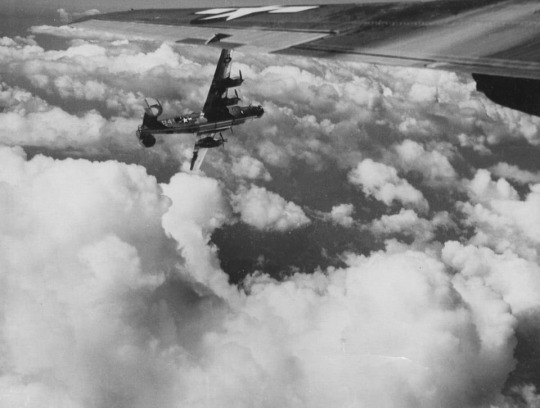
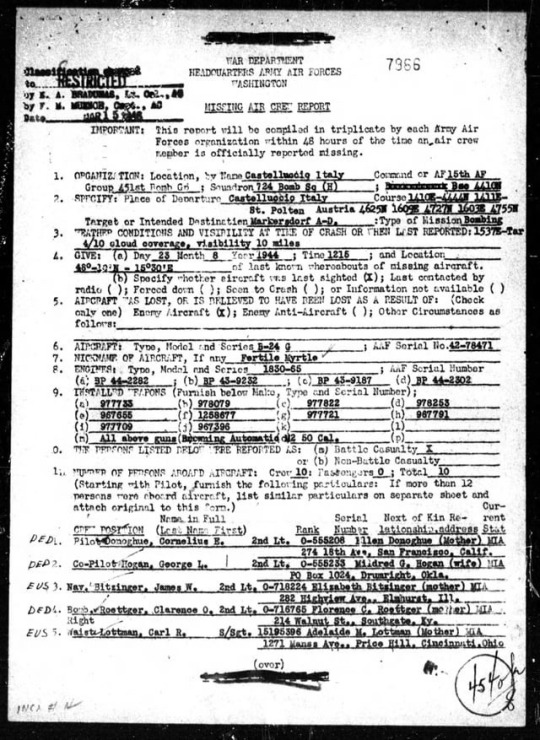


Last image of Consolidated B-24G Liberator 42-78471 "Fertile Myrtle" banking away after being attacked by Luftwaffe fighters over Austria on August 23rd 1944 along with excerpts from the Missing Air Crew Report.
21 notes
·
View notes
Text

This Is What It Took To Defend A B-17 Bomber
Manning the .50 caliber machine guns aboard a U.S. Army Air Force heavy bomber was a tough and at times terrifying job.
Thomas NewdickPUBLISHED Jan 31, 2024 5:00 PM EST
World war two aircraft: B-17G Fortresses of the 381st Bomb Group in flight, Summer 1944.
(Photo by PhotoQuest/Getty Images
With the first episodes of Masters Of The Air having received considerable praise for their air combat sequences especially, the story of the U.S. Army Air Forces (USAAF) in World War II is very much back in the public consciousness. In its initial review of the series, The War Zone noted its attention to detail, especially in the terrifying scenes of B-17s flying into flak or being attacked by Luftwaffe fighters.
The combination of simulated concussive blasts, shrapnel, and machine gun rounds very effectively summon up the chaos of the daytime bomber offensive. Meanwhile, the frantic efforts of B-17 gunners to defend their aircraft from enemy fighters that seemingly press home attacks from every quarter are also a signature motif within this drama.
With that in mind, it’s worth looking at what went into these defensive measures and how they changed as the bomber offensive developed, taking the war ever further into Nazi Germany and occupied Europe.
youtube
In the interwar period, proponents of the bomber were convinced that, according to the words of future U.K. Prime Minister Stanley Baldwin, speaking in 1932, “The bomber will always get through.”
With no truly effective defense against bombers, the defenses that armed the bombers themselves were understandably neglected.
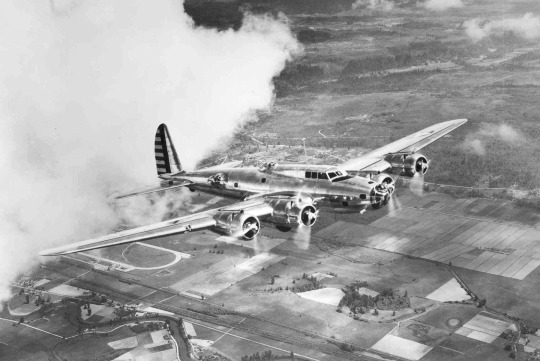
In an expression of the “bomber will always get through” mantra, the initial service test version of the B-17, the Boeing Y1B-17, was armed with just five 0.3-inch machine guns in flexible mounts. Public Domain, U.S. Air Force
Broadly speaking, it was this thinking that saw the bombers of the U.S. Army Air Forces go to war in Europe without fighter escort. The British, for their part, had learned the hard way about the vulnerability of daylight bomber operations without escort and had switched primarily to nighttime raids.
As it was, the USAAF heavy bombers that began flying raids over Europe from their bases in England in the summer of 1942 relied on a combination of formation tactics — primarily the ‘combat box’ and variations of it — and the crew-operated 50-caliber machine guns that armed the B-17s, numerically the most important bomber of the Eighth Air Force flying from England.

A depiction of a combat box formation for a squadron of 12 B-17s. Annotations show: 1. Lead element 2. High element 3. Low element 4. Low low element. Anynobody/Wikimedia Commons
The growing realization that a heavy bomber operating in daylight, regardless of formation, could swiftly fall victim to an enemy fighter is reflected in the steady increase in the defensive firepower on the B-17. Defense of the B-17C model was initially entrusted to just four of the ubiquitous 50-caliber Browning M2 machine guns and a single 0.3-inch machine gun in the nose. The ultimate B-17G bristled with 13 50-caliber Brownings, firing at a rate of 750 rounds per minute out to an effective range of around 3,500 feet.
In the B-17G, these guns were located in a twin chin turret, a twin top turret above the fuselage, a twin ball turret below the belly, a twin tail turret, plus single trainable guns in ‘cheek’ positions on either side of the nose, in the radio compartment in the upper fuselage, and in ‘waist’ positions on either side of the rear fuselage. Typically, the ball turret and tail turret were manned by dedicated gunners, while the other guns were operated by other members of the crew as needed.

A B-17G of the 306th Bomb Group, fitted with a chin turret, from a photograph dated November 1943. The original caption read: “The new chin turret — so-called because it is fitted under the ‘chin’ of the aircraft — is the latest addition to the armor of the Flying Fortress.” United States Army Air Forces

A gunner sights his machine gun through the Plexiglass hood that was introduced over the radio compartment in the upper fuselage, amidships on the B-17, in a photo dated September 1944. Photo by PhotoQuest/Getty Images
The top turret and ball turret were electro-hydraulically powered and could bring the guns to bear on a target rapidly, traversing at some 50 degrees per second and electrically fed with ammunition. The tail turret was manually operated while the remaining trainable guns were on pivoted mounts, meaning the gunners had a limited field of fire and had to wrestle with the slipstream as they tried to get the enemy in their sights. Those sights were initially of the primitive ring-and-bead type, later superseded by reflector sights, making deflection shooting more reliable.
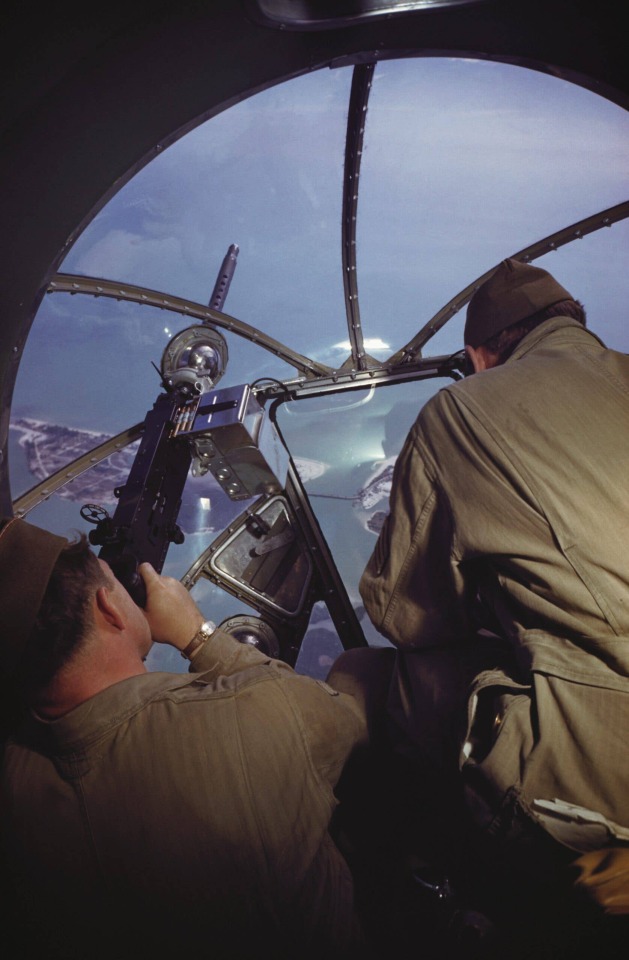
Bomber crew in the nose of a B-17 in the run-up to World War II. The limited traverse available on the gun mounted in the nose transparency is evident. Photo by Ivan Dmitri/Michael Ochs Archives/Getty Images
Despite the impressive concentration of firepower, an individual bomber remained highly exposed, especially during its run-in to the target, when it needed to fly straight and level.

A gunner sitting at his action station in a B-17 ball turret, September 1944. Photo by Mondadori via Getty Images
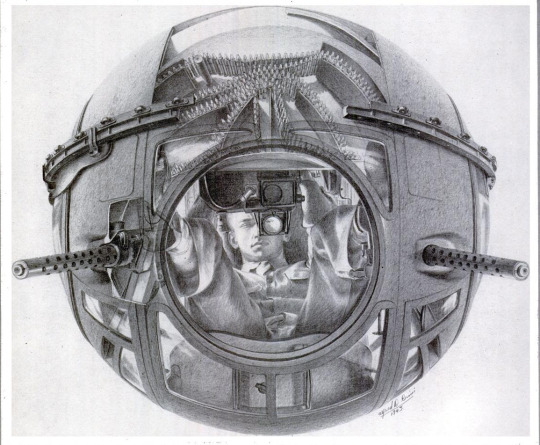
A wartime illustration of a Sperry Ball Turret, of the kind that armed versions of both the B-17 and B-24. The foetal position of the gunner and the ammunition feed mechanism are seen to good effect. Alfred D. Crimi, illustration for United States Army
The combat box was therefore soon developed to provide mutual protection, with interlocking arcs of fire provided by bombers flying in formation and staggered at different levels. This presented Luftwaffe fighters with a bigger problem and helped ensure that bombs were delivered close to the chosen target. This latter point was especially important bearing in mind the high altitudes from which these raids were typically flown. However, these tactics also required the bombers to stay in rigid formation if it was to be successful — counterintuitive when coming under attack from fighters or anti-aircraft fire from the ground.
Ultimately, as formations grew in size, the combat box was refined to become the ‘wing box,’ comprising three staggered 18-plane boxes for a total of 54 bombers. This was especially challenging for crews, with closely packed bombers running into each other’s turbulence and with a risk of bombs from a higher stack hitting aircraft flying below. When it worked, however, the wing box provided roughly 700 defensive machine guns that could be brought to bear on fighter opposition.
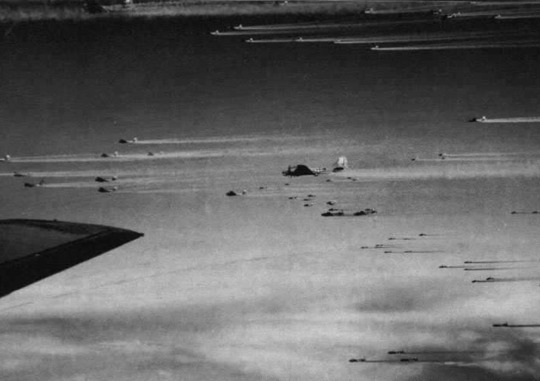
The view into a multi-ship B-17 bomber stream during World War II. These examples are purportedly from the 493rd Bomb Group, 3rd Bomb Division. U.S. Air Force photo
As well as falling bombs, there remained the risk of fratricide of another kind, too. While bombers’ gun turrets were designed to fire on arcs that ensured the aircraft’s tail, for example, would not be shot off, the same was not the case for other bombers flying nearby.
Other changes to the combat box tactics followed, including looser formations of 27 or 36 aircraft once flak superseded fighters as the primary threat to the bombers. The need for more spacing was driven by the fact that the detonation of a single anti-aircraft shell from a flak gun could potentially knock out more than one bomber. Once radar-guided Pathfinder groups became available, this also allowed bombers to operate with greater separation between them and still hit their target reasonably accurately, even in poor weather.

A B-17 crew of the 306th Bomb Group stand underneath the flak-damaged wing of their B-17, nicknamed Holy Hellcat, in 1943. United States Army Air Forces
Whatever the tactics, the process of getting bombers into compact formation was also far from easy. Considerable training was required beforehand and, for the missions themselves, assembling the bombers in their boxes needed a lot of time and energy on the part of the crews and consumed precious fuel. Some accounts suggested it took roughly an hour to get into formation at the start of a mission. Flamboyantly painted ‘assembly ships’ were among the initiatives developed to make the process easier.
At the same time, the Luftwaffe was adapting its tactics to deal with larger and better-armed USAAF bomber formations. In particular, German fighter pilots made high-speed ‘slashing’ attacks.
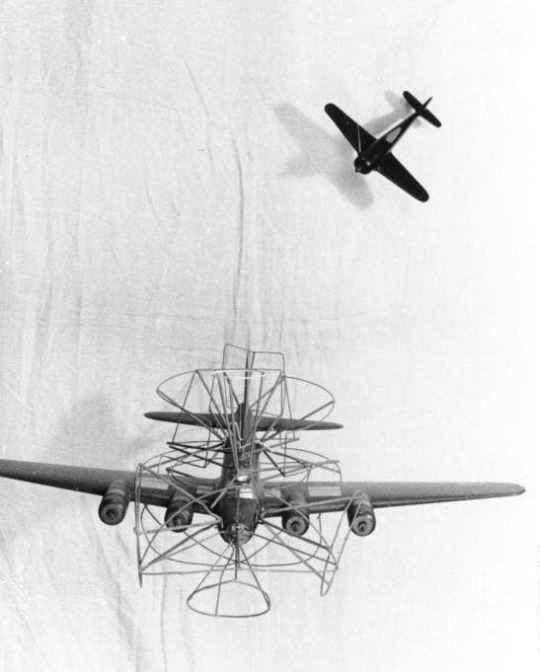
A model of a B-17E/F with latticework showing the directions of fire from its defensive machine guns, for the aid of a Luftwaffe Fw 190 fighter pilot, circa 1943–44. German Federal Archives
Despite the lack of fighter opposition at the start of the USAAF bombing campaign, it was far from easy for the Luftwaffe to bring down a big B-17 or B-24 bomber.
One Luftwaffe report indicated that around 20 hits from 20mm cannon shells (far more destructive than the bombers’ own machine guns) were needed to destroy a USAAF heavy bomber in an attack from the rear. At the same time, the average Luftwaffe pilot would hit a bomber with only around two percent of the rounds they fired; that translated to a requirement of 1,000 20mm rounds to ensure a bomber’s destruction. A Luftwaffe Fw 190 fighter carried only 500 rounds.
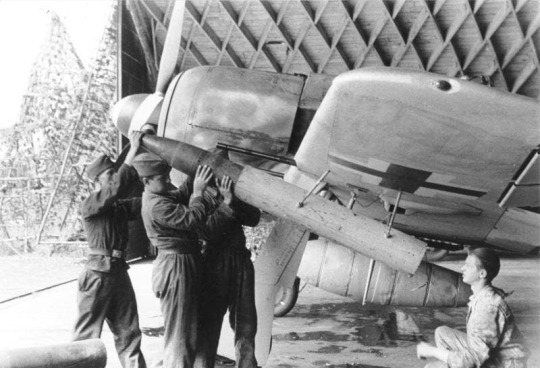
A Luftwaffe Fw 190 is loaded with 21-cm-Werfergranaten (WfG. 21) rockets, to be used to attack heavy bombers, in 1943. German Federal Archives
It’s notable, too, that as well as adding more defensive guns, the bombers also received more and improved armor, making the Luftwaffe’s task harder still.
Attacking a bomber head-on provided better odds for the Luftwaffe pilot, since the bomber’s forward-firing defensive armament was more limited, and its armor less effective. Destroying a bomber from head-on could be achieved with four or five 20mm hits, according to Luftwaffe studies. However, this was also addressed in the program to up-arm the USAAF ‘heavies,’ including the B-17’s chin turret.
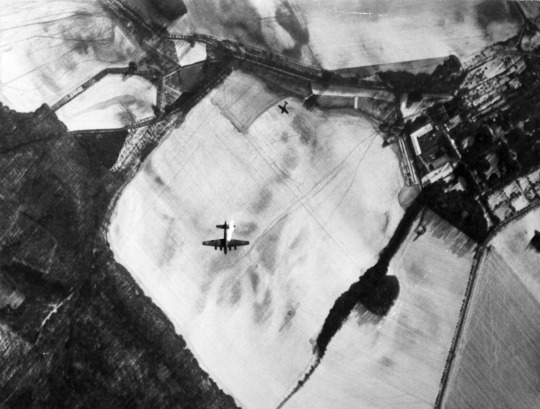
A Focke-Wulf Fw 190 shoots down a USAAF B-17G during an attack on the AGO Flugzeugwerke Aircraft factory at Oschersleben, Germany, January 11, 1944. U.S. Air Force photo
Once again, as the USAAF bombers added guns, the Luftwaffe in turn increased its firepower, adding more ammunition, cannons in ever-heavier calibers, and later even air-to-air rockets. These initiatives may have been driven primarily by the requirement for heavy-hitting weapons that would be more likely to destroy a heavy bomber in a single pass, but they also increasingly out-ranged the bombers’ defensive guns. Fortunately for the Eight Air Force, the 21-cm rocket, despite its large warhead, was less than reliable.
In action, the 21-cm-Werfergranaten (WfG. 21) rocket proved relatively ineffective. “It downed few bombers, but it often damaged planes sufficiently to force them out of formation so that other fighters could finish them off,” the aviation historian Alfred Price recalled.
In October 1943, an Eighth Air Force raid against the ball-bearing production center at Schweinfurt, in southern Germany, demonstrated to USAAF leadership that a different approach would be needed if the bombers were to survive.
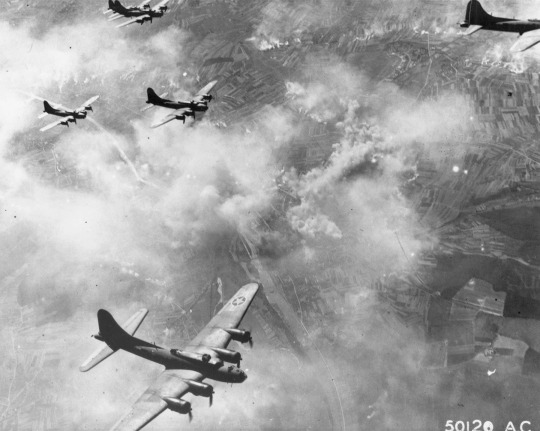
USAAF B-17Fs in formation over Schweinfurt, Germany, during an earlier raid on the ball-bearing production center on August 17, 1943. U.S. Air Force photo
By this stage, fighter escorts were available to the USAAF bombers, but, as the Schweinfurt raid of October 14, 1943, demonstrated these protective assets were too few in number and their range too short to ensure adequate protection.
The second Schweinfurt raid saw 291 B-17s sent against the target, of which 60 were lost outright, 17 damaged beyond repair, and another 121 damaged to one degree or another. A staggering 22 percent of the bomber crews involved — around 650 out of 2,900 men — were killed.

A B-17 of the Eighth Air Force heads back from the raid against Schweinfurt, Germany, on October 14, 1943, an operation that came to be known as known as ‘Black Thursday.’ U.S. Air Force photo
The USAAF responded by suspending unescorted daylight bomber raids deep into Germany until February 1944. When they recommenced, P-51B long-range escort fighters were available to provide the bombers with the close defensive protection they so badly needed. Flying ahead of the combat boxes, the P-51s would ultimately wrest control of the skies from the Luftwaffe’s fighter force. They would be aided in this by the tide of the war turning against Germany more generally, depriving it of the resources it needed to try and blunt the Allied bomber offensive.
Between February and June 1944, this combination of factors finally saw the B-17 emerge as a survivable asset. After the successful ‘Big Week’ raids of early 1944, Berlin was now in the USAAF’s sights. The first Eighth Air Force raid on the capital of the Third Reich came in March.

Tika IV, a P-51D flown by Lt. Vernon Richards, serving with the 374th Fighter Squadron, 361st Fighter Group. United States Army Air Force/361st FG Association, via Al Richards
The Luftwaffe’s response, from now on, was fairly tokenistic. The jet-powered Me 262, armed with heavy cannons and also rockets, was a formidable bomber-destroyer but fielded in numbers too small to be meaningful and its operations were hampered by shortages of pilots and fuel. The rocket-powered Me 163, on the other hand, offered blistering performance that allowed it to pass through bomber streams unscathed, but was arguably more lethal for its pilots than the Eighth Air Force.
Until the Eighth Air Force finally got the upper hand over Europe, survival had very much been down to the bravery and skill of the bomber crews themselves. While they were aided by the ability of the B-17, especially, to absorb a significant degree of battle damage, their machine gun armament was more than just a morale-booster.
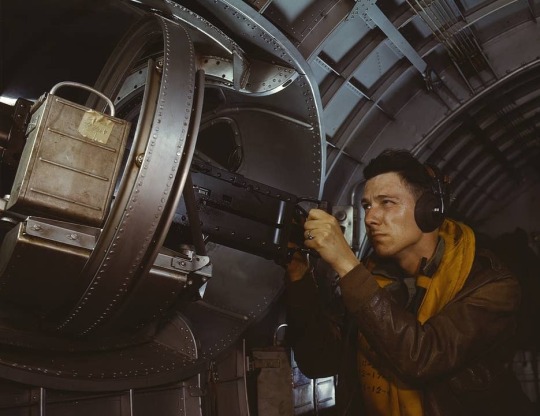
“Hitler would like this man to go home and forget about the war. A good American non-com at the side machine gun of a huge B-17 bomber is a man who knows his business and works hard at it” — the original caption of a staged wartime propaganda photo showing a B-17 waist gunner. Collection Library of Congress, Transfer from U.S. Office of War Information, 1944
The bombers’ defensive armament and the tactics designed to best exploit it forced the Luftwaffe to change its approach. Gunners also achieved success, with the Eighth Air Force claiming 6,259 enemy aircraft destroyed by bomber gunners, more than for its fighter pilots. There is no doubt, however, that attributing fighter ‘kills’ was tricky in the heat of combat. Often, multiple gunners would open fire on the same target, observation of confirmed wreckage was far from guaranteed, and there was no gun-camera footage. Limited recognition of gunner aces reflected these realities, but at the same time, their enlisted status (for the most part), meant they were often also omitted from official lists of USAAF aces.

B-17s from the 398th Bombardment Group fly a bombing run to Neumunster, Germany, on April 13, 1945, less than one month before the German surrender on May 8. U.S. Air Force photo
Regardless, their job was a vital one and their mission among the most hazardous imaginable.
“When he was not shooting or being shot at, the gunner’s prime concern was survival,” Bruce D. Callander wrote in the April 1, 1991, issue of Air & Space Magazine.
“Missions lasted up to eight hours, with much of the flying taking place above 25,000 feet. Temperatures dropped as low as minus 60 degrees Fahrenheit in bombers that had no insulation and little heating outside the flight deck. Fleece-lined flight jackets were scant protection. The earliest electrically heated suits often shorted out and burned their occupants. Waist gunners worked through open windows, suffered frozen fingers, and slipped on the spent shells that piled up at their feet. Turret gunners had slightly more protection from the elements, but their cocoons allowed little room to move an aching arm or to stamp a cold foot.”
With hindsight, it’s clear that the availability of high-quality long-range escort fighters in sufficient numbers was the decisive factor in reducing Eighth Air Force bomber losses to a more acceptable level. But until those fighters were fielded, the bomber crews themselves more often than not provided their aircraft with the first and last line of defense.

1st Lt. George H. Heilig waves and gives the okay sign from the cockpit of the General Ike, a B-17 from the 401st Bomb Squadron, 91st Bomb Group, Eighth Air Force, England, circa 1944. Photo by PhotoQuest/Getty Images
Interestingly, there was a school of thought in the United Kingdom, at least, that suggested that the Royal Air Force might have been better off removing defensive guns from its World War II bombers altogether.
The theoretical physicist and mathematician Freeman Dyson, in 1943, proposed removing at least some of the gun turrets from Lancaster bombers, to provide what he claimed would be a 50 m.p.h. increase in cruising speed. The unarmed Mosquito relied on its speed for protection from Luftwaffe fighters, but it was a far higher-performing aircraft in general and it seems highly unlikely that an unarmed Lancaster would have been much more survivable.
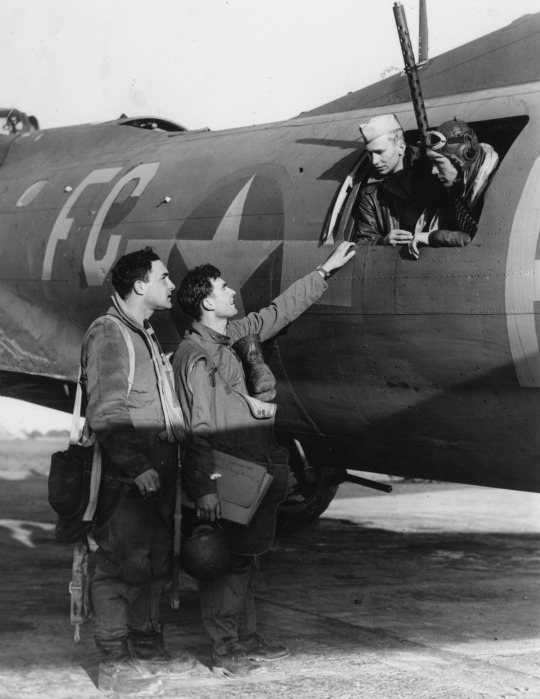
August 1943: United States Army Air Forces bomber crewmen with their B-17. Visible are the left-side waist machine gun, as well as the ball turret and the gun protruding from the radio compartment in the upper fuselage. Photo by Hulton Archive/Getty Images
This brings us again to the morale factor and the very important fact that USAAF and Royal Air Force heavy bomber crews were able to fight back with defensive armament, even if their guns were still at a disadvantage against the Luftwaffe in terms of destructive power.
While precise tallies of the Eighth Air Force gunners’ successes can never be determined, their legacy was continued in the postwar U.S. Air Force, which continued to arm its strategic bombers with guns, finally only in the tail, right up until the B-52H. The B-52H still serves today, albeit with its tailguns now deleted. Fittingly, the B-52 and the service’s other strategic bombers come under the command of the Eighth Air Force — the very same formation whose gunners fought so valiantly for the liberation of Europe back in World War II.
Contact the author: [email protected]
40 notes
·
View notes
Text
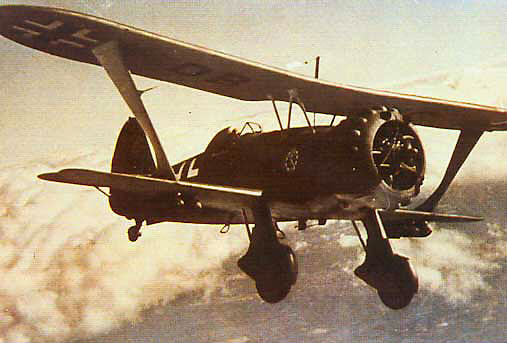
The Luftwaffe's first Sturzkampfflugzeug (Stuka/dive bomber), the Henschel Hs 123. A fantastic ground attack/dive bomber that was the first aircraft Henschel built, until then having previously been known for building locomotives. The aircraft debuted in Spain, Adolf Galland being an early user. These little aircraft were so good, that in Jan 1943, Generaloberst (Colonel General) Wolfram von Richthofen of Luftflotte (Air Fleet) 4 inquired whether Henschel could restart the production of Hs 123 biplanes due to their flexibility on the front lines, particularly with their capability to take off and land on muddy airfields, but Henschel had since dismantled the entire Hs 123 production line, making the request impossible. They served until the end of the war and could absorb a high level of damage. For more, see my Facebook group - Eagles Of The Reich
#germany#ww2#luftwaffe#ww2 aircraft#henschel#condor legion#adolf galland#hs 123#stuka#ww2 dive bombers
104 notes
·
View notes
Photo
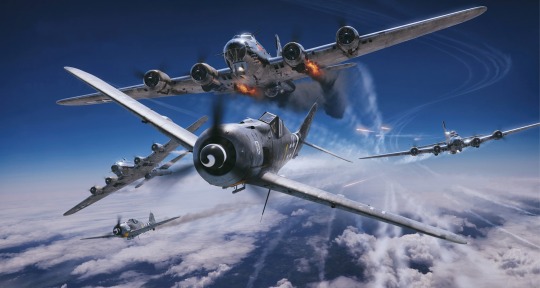
Focke-Wulf Fw 190
©Artwork by ?
#WWII#Artwork#Luftwaffe#Aviation militaire#Military aviation#Avion de chasse#Chasseur#Fighter#Chasseur-bombardier#fighter-bomber#Avion d'attaque au sol#Ground-attack aircraft#Focke-Wulf Fw 190#Fw 190
31 notes
·
View notes
Text

Tracer fire from anti-aircraft batteries and searchlights light up the sky during the first air raid on Moscow - July 22 1941. 220 German Heinkel He-111s and Dornier Do-217s flown by select Luftwaffe pilots with new high-altitude engines attacked for approx five hours. Although there were a number of air raids over Moscow, these were very infrequent and largely ineffective
#world war two#1940s#worldwar2photos#history#ww2#ww2 history#wwii#wwii era#world war 2#ww2history#ww2colourphotos#air raid#kremlin#Moscow#soviet union#luftwaffe#tracer#searchlights#1941
80 notes
·
View notes
Text
100th Bomber Boys: Major Robert 'Rosie' Rosenthal: Pt. 2

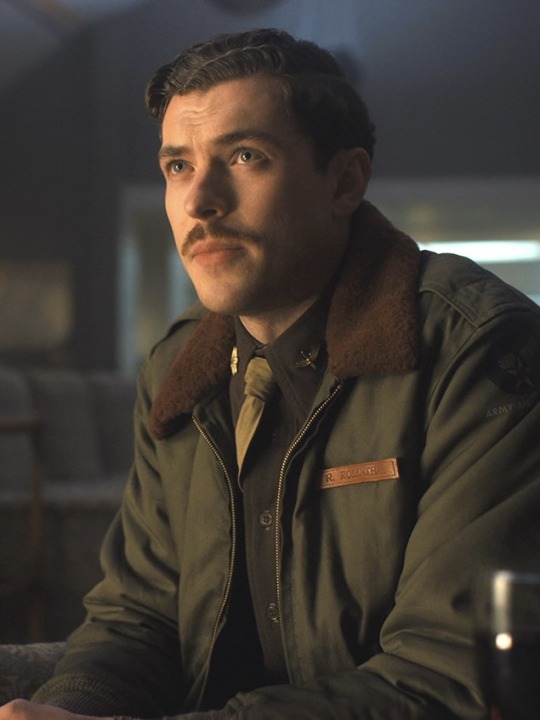

If you missed part 1, you can find it here!!
Following the Munster mission in October of 1943 that decimated the 100th bomb group, Rosenthal took on a leadership role among the men. With Egan and Cleven gone, the men needed someone they could look up to for strength and guidance. Even though the Münster mission was only his third, he and his crew were sent on a week's leave. Following their leave, the 100th was one of the first to bomb the capital city of Berlin.
The next objective for the 8th Air Force was to achieve total European air supremacy in order to prepare for the D-Day landings. Their job was to take out the Luftwaffe, starting with the factories and plants that manufactured various parts for various MEs and other German fighter planes. The introduction of the P-51 Mustang, a long-range fighter plane that could accompany the B-17s to their targets. These planes ended up changing the tide of the air war.
The Mustangs were taking out Luftwaffe planes at an astounding rate with small loss rates. This development led to the B-17s essentially being used as bait for the Luftwaffe planes to attack so that the Mustangs could swoop in and destroy the withering German air force. The Luftwaffe was losing its veteran pilots, making the force less lethal than it was at the beginning of the war.
(pg. 281: Don Miller's Masters of the Air)
In May 1944, two months after completing twenty-five missions with the crew of Rosie's Riveters, he took over the 350th Bomb Squadron of the Hundredth, whose morale and efficiency had slipped badly, and began to restore the unit to peak performance. "After the first Berlin raids, we had men who were banged up mentally, and a few of them didn't want to fly anymore. I told them they had a moral obligation to fly, and that I would fly with them. We were here to beat Hitler. I also told them that if they didn't fly they would be letting down friends who had helped to keep them alive up to now. The appeal to their pride and respect worked better than the one to their patriotism." Rosenthal knew that without group loyalty-the responsibility that fighting men feel to the men next to them - wars would be impossible. Gale Cleven and John Egan "gave the 100th its personality," wrote Harry Crosby. "Bob Rosenthal helped us want to win the war."
In the end, however, Eighth Air Force morale improved markedly only when casualty rates declined. That began to happen in May 1944, after American fighter pilots had reduced the Luftwaffe's effectiveness. "We did the bombing-the dirty work," said Rosenthal, "We were the decoys, and they took care of the bad boys that had been beating us up. They were guys who made D-Day possible?""
In early May, the 8th took the war to synthetic oil refineries in Germany, knocking a major blow to the Nazi war machine. The Germans did not have much natural oil in their territory, and even when they invaded Poland in '39, they only had enough oil reserves to last the army, air force, and navy for a few weeks. With their addition of conquered territories, the shortage became less of a problem, but in a military that mainly used oil (instead of coal like the rest of Germany) any shortage was a problem. In response, they began manufacturing synthetic oil in hydrogenation plants using the Bergius process, named after its inventor, Nobel-Prize-Winning Friedrich Bergius (that I am not smart enough to explain). This oil was keeping the Nazi military going, and striking it made a huge dent in their war-making capabilities. Unfortunately, Gen. Carl 'Tooey' Spaatz's bombing offensive was put on hold to prepare for the Normandy invasion. This time, the 8th and 15th Air Forces would be bombing Germany's important industries in France.
It was the last week of May, and the time had arrived to soften the Germans up for D-Day. The plan was to hit the main points of German transportation in occupied France, including railroad marshaling yards in Northern France and Belgium. This was supposed to delay the enemy's ability to bring reinforcements, tanks, and other supplies that would be needed to fight the Allied invasion on June 6th. The offensive turned out to be a major success. "Allied heavy and medium bombers almost completely dismembered the rail network of northern Belgium and France, choking off the main supply channel that fed the German army (Miller, 2007, pg. 291)." Bridges over the Loire and the Seine were also smashed, "cutting off most of Normandy and Brittany from the rest of France (Miller, 2007, pg. 291)."
Then on June 6th, 1944, the 100th was tasked with bombing the German strongholds along the beachheads. They were not very successful, but their earlier missions were the things that made the invasion possible.
(pg. 294: Don Miller's Masters of the Air)
For nearly every Allied airman who flew that day, it was the greatest experience of the war. "I briefed the crews of the 100th," recalls Rosie Rosenthal, "and I had never seen such a reaction from them. They stood and cheered and roared. This is the day they had been looking toward. I led the group on the third bombing mission of D-Day, toward dusk. We had a rule. No one could talk on the intercom unless it was absolutely necessary-radio discipline. But as we passed over that vast armada and headed over the beaches, a member of our crew started to say a prayer for the people down below and we all joined in. It was one of the most emotional moments of my life."

tag list: @luckynumber4 @footprintsinthesxnd @georgieluz @sweetxvanixlla @coco-bean-1218
message or comment if you want to be added to the tag list! <3

#hbo war#masters of the air#major robert rosenthal#major robert rosie rosenthal#rosie rosenthal#road to masters of the air#nate mann#gale cleven#major john egan#major buck cleven#about masters of the air#hbowar#hbowar info#gale buck cleven#john egan#1940s#wwii#100th bombardment group#100th bomb group#8th air force#eighth air force
21 notes
·
View notes